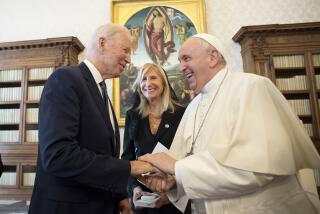Jobless to Get Cash in Bush Plan
- Share via
WASHINGTON — President Bush decided late Monday to add billions of dollars to the economic growth package he is due to unveil today in order to create $3,000 “personal reemployment accounts” for those who are hardest to hire.
Aides were urging the president to add billions more to offset an unintended consequence of his plan: a further decline in the tax revenue of already cash-strapped states.
The employment accounts and proposal for state aid, which together would cost $10 billion, would apparently be the only two spending measures in the $600-billion plan that the president is set to present in a speech in Chicago. The rest would be tax cuts, which the White House says would benefit more than two-thirds of taxpayers beginning in 2003.
The employment accounts would foreshadow an effort by the administration to “privatize” large portions of Washington’s unemployment and job training programs by shifting responsibility to states and individuals. Those qualifying for the money could use it for job training, transportation or child care while they are unemployed and could keep whatever is left once they are rehired.
In remarks to reporters Monday, the president highlighted tax cuts in his package and asserted that the measure would benefit all Americans.
“This is a plan that provides tax relief to the working citizens,” Bush said. “It’s a plan that is a very fair plan. It’s a plan that recognizes when somebody has more of their own money, they’re likely to spend it, which creates more jobs.”
Democrats reacted by offering a rival package Monday and accusing Bush of favoring the rich.
“The president is really investing $600 billion on an old Republican theory of trickle-down economics,” said Rep. George Miller (D-Martinez). “We’re saying no. Give it to the people.”
The two sides sounded a rare note of agreement in pledging to rush through a 13-week extension of unemployment compensation that lapsed shortly after Christmas. Analysts said that if Congress passes the extension and Bush signs it by week’s end, there will be no lapse of benefits for jobless workers collecting under the program.
The unemployment accounts appear to be the opening gambit in an administration push to overhaul the government’s unemployment and job training programs.
An internal document from the Office of Management and Budget shows that the White House is seeking to end the government’s $800-million-a-year employment services program next year, consolidate about $2 billion in training programs and turn the money over to the states.
Bush’s proposal to eliminate dividend taxes would cost the government $300 billion over 10 years in lost tax revenue, and account for half the price of the president’s growth plan. Other key elements of the plan include:
* A speedup to this year of already approved income tax rate cuts, now scheduled to take effect in 2004 and 2006 at a cost of about $90 billion. The move will slice the top tax rate for every dollar over a certain amount from its current 38.6% to 35%. The three remaining brackets would be reduced a full 2 percentage points.
* A speedup from 2010 to this year of an already approved expansion of the child tax credit from $600 to $1,000. The move would cost Washington almost $100 billion.
The reemployment accounts and the state aid, if included in the final plan, are only one-year programs, in contrast to the elimination of the dividend tax, which would be permanent, and the income tax rate cuts, which would remain in effect until 2010. As a result, their price tags are considerably smaller than those for the tax cuts.
In addition, the aid package, which would funnel $6 billion to financially troubled state governments, is largely designed to solve a problem that Bush’s elimination of the dividend tax is expected to create for states -- a reduction in their already diminished tax revenue.
The problem occurs because in eliminating the dividend tax -- rather than just reducing it -- the administration would wipe out the need for companies to tell Washington what they pay in dividends and the need for the Internal Revenue Service to collect the information.
As a result, states, which also tax dividends based on the federal information, would no longer be able to impose that tax. The inability would cost them from $4 billion to $5 billion in lost revenue a year, according to the independent Center for Budget and Policy Priorities.
The loss would mean the extra federal aid would effectively total only $1 billion and last only one year.
It would be a drop in the bucket for states, which, according to the National Governors Assn., face budget shortfalls totaling $67 billion.
Administration officials said that 1.2 million workers, or about 15% of the nation’s unemployed, would be eligible for the reemployment account money, which they could use for expenses designed to get them off the jobless rolls.
The unemployed who find new employment within 13 weeks can keep what is left of the $3,000 as a bonus -- 60% of it as soon as they start work, and 40% after they remain on the job for six months.
The official said the idea was influenced by Department of Labor studies showing that bonuses as small as $400 helped workers return to work faster.
“This is obviously to encourage job retention,” the administration official said.
More to Read
Get the L.A. Times Politics newsletter
Deeply reported insights into legislation, politics and policy from Sacramento, Washington and beyond. In your inbox three times per week.
You may occasionally receive promotional content from the Los Angeles Times.










